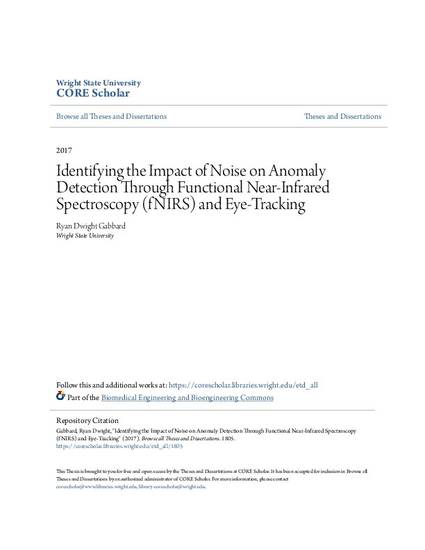
Thesis
Identifying the Impact of Noise on Anomaly Detection Through Functional Near-Infrared Spectroscopy (fNIRS) and Eye-Tracking
(2017)
Abstract
Occupational noise frequently occurs in the work environment in military intelligence, surveillance, and reconnaissance (ISR) operations. This impacts cognitive performance by acting as a stressor, potentially interfering with the analysts' decision making process. In this study the effects of different noise stimuli on analysts' performance and workload in anomaly detection were investigated by simulating a noisy work environment. Functional near infrared spectroscopy (fNIRS) was utilized to quantify oxy-hemoglobin (HbO) and deoxy-hemoglobin (HbD) concentration changes in the prefrontal cortex (PFC), as well as behavioral measures which include eye-tracking, reaction time, and accuracy rate. It was found that HbO for some of the channels analyzed were significantly different across noise types (p<0.05). The results indicated that HbO activation for short intermittent noise stimuli was greater in the PFC compared to long intermittent noises. Target transition rates were also significantly higher (p<0.05) for no noise conditions compared to noise filled environments. These approaches using fNIRS in conjunction with an understanding of the impact on human analysts in anomaly detection, could potentially lead to better performance by optimizing work environments.
Keywords
- fnirs,
- eye movements,
- brain
Disciplines
Publication Date
Summer June 20, 2017
Degree
Master of Science in Biomedical Engineering (MSBME)
Department
Biomedical, Industrial and Human Factors Engineering
Advisor
Mary Fendley ; Nasser Kashou
Citation Information
Ryan Gabbard. "Identifying the Impact of Noise on Anomaly Detection Through Functional Near-Infrared Spectroscopy (fNIRS) and Eye-Tracking" (2017) Available at: http://works.bepress.com/nasser_kashou/36/
